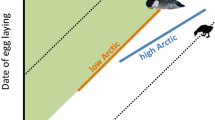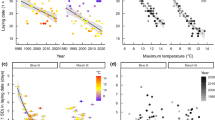Abstract
Numerous facts regarding a shift in birds’ breeding time on the background of climate warming have been accumulated over the past decades. Most studies note a correlation between the population laying date and the temperature of a certain period, but the reasons and mechanism of this relationship remain unclear. Individual-based genetic studies, despite their significant success, are too complex and time-consuming, and their resolution is still insufficient to prove directed genetic changes associated with climate warming. We have implemented a population-based approach to the analysis of laying dates in 6054 nests of the most abundant species in a poorly studied natural region for the period from 1974 to 2016. In the search for the maximum climatic dependence, we checked the influence of three weather indicators, different exposure dates, and the response of each fraction of the population that successively enters breeding. We have found that the maximum response is associated with a phenological indicator based on the sum of active temperatures. The greatest influence fell in the 35% quantile of the laying dates in the season, which coincided with the modal day in the population. The difference of the phenological situation from the norm at the beginning of nesting was maintained for the following weeks and thus could serve as a reliable source of information on the timing of prospective food abundance. This must increase the efficiency of selection for an optimal laying date according to the results of reproduction, thereby explaining the mechanism of climate reaction. We decomposed the observed laying dates and the dates of achievement of the necessary phenological conditions into components associated with a long-term trend and annual fluctuations. Comparing these data series, we obtained an independent assessment of the environmental influence on annual deviations and the long-term displacement of breeding dates. The annual deviations of the conditions caused a proportional response: short-distance migrants compensated for the environmental change by about half, long-distance migrants by nearly 1/3, and the eastern migrants compensated less than half as much as the western ones. Under extreme phenological conditions, the response of some species was less than proportional, which indicated the limit of phenotypic plasticity. In years that separated by a long interval but similar in spring phenology, egg laying occurred significantly earlier. Over the entire observation period, the spring phenology shifted by more than 12 days and caused the same shift in the nesting time in short-distance migrants, while long-distance migrants compensated for the shift by less than 2/3. The long-term shift in the laying dates has exceeded their standard deviation in populations by an average of 2.7 times. Thus, the described phenomena go well beyond phenotypic plasticity and suggest that there is a significant genetic shift in laying dates.





Similar content being viewed by others
REFERENCES
Berthold, P., Control of Bird Migration, London: Chapman and Hall, 1996.
Both, C., Artemyev, A.V., Blaauw, B., Cowie, R.J., Enemar, A., et al., Large-scale geographical variation confirms that climate change causes birds to lay earlier, Proc. R. Soc. Lond. B., 2004, vol. 271, no. 1549, pp. 1657–1662.
Charmantier, A. and Gienapp, P., Climate change and timing of avian breeding and migration: Evolutionary versus plastic changes, Evol. Appl., 2014, vol. 7, no. 1, pp. 15–28.
Charmantier, A., McCleery, R.H., Cole, L.R., Perrins, C., Kruuk, L.E., and Sheldon, B.C., Adaptive phenotypic plasticity in response to climate change in a wild bird population, Science, 2008, vol. 320, no. 5877, pp. 800–803.
Cornulier, T., Elston, D.A., Arcese, P., Benton, T.G., Douglas, D.J., et al., Estimating the annual number of breeding attempts from breeding dates using mixture models, Ecol. Lett., 2009, vol. 12, no. 11, pp. 1184–1193.
Crick, H. and Sparks, T., Climate change related to egg-laying trends, Nature, 1999, vol. 399, no. 6, p. 423.
Davis, M.B. and Shaw, R.G., Range shifts and adaptive responses to quaternary climate change, Science, 2001, vol. 292, no. 5517, pp. 673–679.
Dawson, A., Control of the annual cycle in birds: endocrine constraints and plasticity in response to ecological variability, Philos. Trans. R. Soc., B, 2008, vol. 363, no. 1497, pp. 1621–1633.
Dunn, P.O. and Møller, A.P., Changes in breeding phenology and population size of birds, J. Anim. Ecol., 2014, vol. 83, no. 3, pp. 729–739.
Dunn, P.O. and Winkler, D.W., Effects of climate change on timing of breeding and reproductive success in birds, in Effects of Climate Change on Birds, Møller, A.P., Fiedler, W., and Berthold, P., Eds., Oxford: Oxford Univ. Press, 2010, pp. 113–128.
Gienapp, P., Leimu, R., and Merilä, J., Responses to climate change in avian migration time—microevolution versus phenotypic plasticity, Clim. Res., 2007, vol. 35, nos. 1–2, pp. 25–35.
Gienapp, P., Teplitsky, C., Alho, J.S., Mills, J.A., and Merilä, J., Climate change and evolution: Disentangling environmental and genetic responses, Mol. Ecol., 2008, vol. 17, no. 1, pp. 167–178.
Gordo, O., Why are bird migration dates shifting? A review of weather and climate effects on avian migratory phenology, Clim. Res., 2007, vol. 35, nos. 1–2, pp. 37–58.
Gwinner, E., Circannual clocks in avian reproduction and migration, Clim. Res., 1996, vol. 138, no. 1, pp. 47–63.
Halupka, L., Dyrcz, A., and Borowiec, M., Climate change affects breeding of reed warblers Acrocephalus scirpaceus, J. Avian Biol., 2008, vol. 39, no. 1, pp. 95–100.
Handbook of the Birds of the World Alive, del Hoyo, J., Elliott, A., Sargatal, J., Christie, D.A., and de Juana, E., Eds., Barcelona: Lynx Edicions, 2016. https://www. hbw.com/.
Hendry, A.P. and Kinnison, M.T., The pace of modern life: measuring rates of contemporary microevolution, Evolution, 1999, vol. 53, no. 6, pp. 1637–1653.
Jonzen, N., Linden, A., Ergon, T., Knudsen, E., Vik, J.O., et al., Rapid advance of spring arrival dates in long-distance migratory birds, Science, 2006, vol. 312, no. 5782, pp. 1959–1961.
Kingsolver, J.G., Hoekstra, H.E., Hoekstra, J.M., Berrigan, D., Vignieri, S.N., et al., The strength of phenotypic selection in natural populations, Am. Nat., 2001, vol. 157, no. 3, рр. 245–261.
Knudsen, E., Lindén, A., Both, C., Jonzén, N., Pulido, F., et al., Challenging claims in the study of migratory birds and climate change, Biol. Rev., 2011, vol. 86, no. 4, pp. 928–946.
Lehikoinen, E. and Sparks, T.H., Changes in migration, in Effects of Climate Change on Birds, Møller, A.P., Fiedler, W., and Berthold, P., Eds., Oxford: Oxford Univ. Press, 2010, pp. 89–112.
Lehikoinen, E., Sparks, T.H., and Zalakevicius, M., Arrival and departure dates, Adv. Ecol. Res., 2004, vol. 35, no. 1, pp. 1–31.
Merilä, J. and Hendry, A.P., Climate change, adaptation, and phenotypic plasticity: the problem and the evidence, Evol. Appl., 2014, vol. 7, no. 1, pp. 1–14.
Møller, A.P. and Merilä, J., Analysis and interpretation of long-term studies investigating responses to climate change, Adv. Ecol. Res., 2004, vol. 35, no. 1, pp. 111–130.
Parmesan, C. and Yohe, G., A globally coherent fingerprint of climate change impacts across natural systems, Nature, 2003, vol. 421, no. 1, pp. 37–40.
Pearce-Higgins, J.W. and Green, R.E., Birds and Climate Change: Impacts and Conservation Responses, Cambridge: Cambridge Univ. Press, 2014.
Saino, N., Ambrosini, R., Rubolini, D., von Hardenberg, J., Provenzale, A., et al., Climate warming, ecological mismatch at arrival and population decline in migratory birds, Proc. R. Soc. B, 2011, vol. 278, no. 1707, pp. 835–842.
Sheldon, B.C., Kruuk, L.E.B., and Merilä, J., Natural selection and inheritance of breeding time and clutch size in the collared flycatcher, Evolution, 2003, vol. 57, no. 2, pp. 406–420.
Tuhkanen, S., Climatic parameters and indices in plant geography, Acta Phytogeogr. Suec., 1980, vol. 67, no. 8, pp. 1–110.
Usui, T., Butchart, S.H.M., and Phillimore, A.B., Temporal shifts and temperature sensitivity of avian spring migratory phenology: a phylogenetic meta-analysis, J. Anim. Ecol., 2017, vol. 86, no. 2, pp. 250–261.
Visser, M.E., Holleman, L.J.M., and Gienapp, P., Shifts in caterpillar biomass phenology due to climate change and its impact on the breeding biology of an insectivorous bird, Oecologia, 2006, vol. 147, no. 1, pp. 164–172.
Visser, M.E., Caro, S.P., van Oers, K., Schaper, S.V., and Helm, B., Phenology, seasonal timing and circannual rhythms: towards a unified framework, Philos. Trans. R. Soc., B, 2010, vol. 365, no. 1555, pp. 3113–3127.
Funding
The study was supported by grant of the Russian Foundation for Basic Research, project no. 18-04-00269a.
Author information
Authors and Affiliations
Corresponding author
Ethics declarations
Conflict of interests. The author declares that he has no conflict of interests.
Statement on the welfare of animals. All applicable international, national, and/or institutional guidelines for the care and use of animals were followed.
Additional information
Translated by L. Solovyova
Rights and permissions
About this article
Cite this article
Bourski, O.V. Shift of Bird Nesting Time in Central Siberia due to Climate Warming: Phenotypic Plasticity or Genetic Shift?. Biol Bull Rev 11, 303–316 (2021). https://doi.org/10.1134/S2079086421030026
Received:
Revised:
Accepted:
Published:
Issue Date:
DOI: https://doi.org/10.1134/S2079086421030026




